Princes Road
After reading this page, try the Princes Road quiz
See also the Princes Road section on pages 36-39 of the proposed update for Round Hill's conservation character statement:
See also laundries in Princes Road 1891.
General Comments
Princes Road is the continuation of Mayo Road and turning a sharp corner at the junction at the north eastern end there are views through trees to the industrial estate below and up the hill towards the summit of “Round Hill”. Again, many of the roofs have been covered in concrete tiles and most of the houses have replacement windows. Most of these houses have small front gardens with shrubs and planting which softens the outline of the buildings and the front boundary walls. Most of the properties date from the 1880s. Of note is the cast iron street lamp outside no. 76.
On the other side of Princes Road, beyond no 81, is a thin strip of open ground beside the road, which drops steeply. It contains some mature trees that provide valuable screening from the industrial estates to the north, and includes a prominent horse chestnut that is protected by a Tree Preservation Order.
Working mainly with Cook - also with Marston, Chamber, Gurr and McKellow - Hector German (1852-1933) was the architect and surveyor responsible for about half the number of houses in the street.
Streetscape
Between Crescent Road and the junction with the Ditchling Road are continuous terraces of two storey painted houses with canted bays and bracketed eaves of the late 1870s and 1880s. Nos. 1-7 date from 1882 and were built by Scarrett / Tuppen & Tasker. Nos. 9-27 were built by Cook / German in 1878. No. 29 was built by architects Antony & Dixon in 1878. Nos. 39-53 were built by Marston / German in 1878.
Mainly 1878-1890 [Note: 55 & 57 date from 1868 and number 50 from 1875
1-53 (odd) Princes Road (north side)
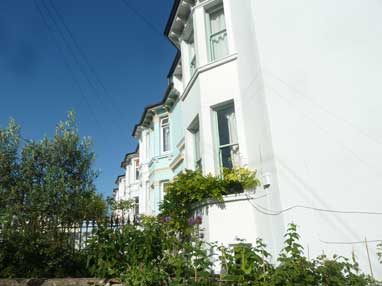
[a] 55 and 57 Princes Road north side
Pair of semi-detached three-storey villas.
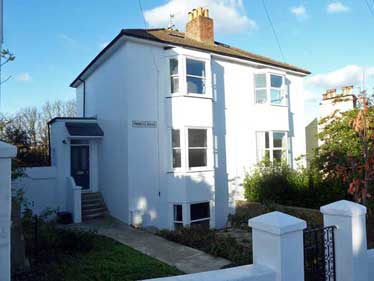
55 and 57 Princes Road builtin 1868 just two years later than Princes Villa, were the first houses in Princes Road. Together with Princes Villa they appear alone on the 1873 OS map Sussex Sheet LXVI . They are set back from later houses in the street, offering larger front gardens. The footprints correspond with the original Round Hill park masterplan by the Conservative Freehold Land Society. Plainer in appearance than many buildings of this period in the area, belying their possible architectural significance as ‘model dwellings’ envisaged in the Conservative Land Society masterplan and the wider Freehold Land Movement aim to provide a route to property ownership and the franchise.
We have a copy of a deed of covenant for No 55 dated 12.12.1867 that other residents in Roundhill are likely to have – when the “Brighton Estate” was divided into building portions, sold by Robert Bourke and Newnham Winstanley.
They drew out the road plan, took responsibility for the roads, footpaths and road drainage and were very specific about building lines, types of property that could be built and their minimum values.
This house was built in 1868, on lot number 352 either by, or for, Joseph Anscombe and was then number 4 Princes Road. The only other property in Princes Road built at that time was Prince’s Villa across the road, with its garden and stables (now Albion Plumbing).
Princes Road has only this one pair of houses and they were cheaply constructed from “bungaroosh”, with water supply only on the lower floor. The specified minimum sale value was £250 for the pair (compared with £400 for one house in Roundhill Cres). We can’t trace tenants until 1883 and wonder if workers were accommodated here while building the other more decorative, terraced houses.
For many years the house was rented and used as a home and small-scale laundry or in associated trades of starching, mending etc. The original wash-house at the rear was demolished in 2015.
They drew out the road plan, took responsibility for the roads, footpaths and road drainage and were very specific about building lines, types of property that could be built and their minimum values.
In 1891, there were at least 18 households acting as laundries in Princes Road. See illustrated article identifying them. On the north side at the summit of the hill, there were four of them. The L-shaped garden of No 53, truncating a few of the gardens to the west, provided plenty of space for drying.
Nos. 59-67 Princes Road were built by Cook / German in 1880.
Nos. 69-81 Princes Road have gables to the street and are clearly more Edwardian in character with casement windows and slated roofs with terracotta ridges. No. 69 appears in street directories from 1926; 71-77 from 1928.; 79-81 from 1933.
No. 69 first appears in Pikes 1926 Directory
Nos. 71-77 first appear in Pikes 1928 Directory
Nos. 79 & 81 first appear in Kellys 1933 Street Directory.
Railway Cottage - the signalman's house
No 83. The railway cottage and signalbox
Facebook pictures of the railway cottage and the signalbox.
About 30 residents in Princes Road had jobs related to the railway in 1891.
The cottage belonging to the signalman was located at a lower level on the site now owned by Billings and Hathaway set back a little from what is now the end of The Centenary Industrial Estate.
Its back garden extended westwards ending at the signal box (also set at a lower level than Princes Road) just outside the NE corner of what is now the Carelet site. The last occupant of railway cottage was Ron French who kept it on after he retired from the railway. He then used the signalbox as his workshop. Both cottage and signalbox were demolished when he moved in 1989 to make way for the final units on the newly built Centenary Industrial Estate. The latter followed the path of The Kemptown branchline. The residents on the opposite side of Lewes Road fared better than us. Thanks to the campaigning efforts of Councillor William Clarke, instead of an industrial estate, the path of the abandoned railway was used as public parkland - a green strip now known as "The Patch" or William Clarke Park. See their Facebook Site. Best when you have a public asset like this to celebrate it through an annual festival to prevent those seeking strips of land for other purposes from getting ideas!
Nos. 2-8 were built by Cooke and Denman in 1879, as were nos. 10 and 12.
Nos. 14 and 16 were built by architects Edmund Evan Scott [1828-1895] and Robert Singer Hyde [1846-1913] in 1881. working together with Chambers.
Nos. 18-24 were built by Gurr / German in 1879. Nos. 26-32 were built by Chambers / German in 1882. Nos. 34 and 36 were built by Chambers / Hunter in 1884.
The Primrose and Tivoli laundries do not arrive at 20/22 and 28 Crescent Road until 1898. The generous strip of drying field on one of the highest terrains in Round Hill (good for catching the wind) probably offered incentive.
Princes Villa - the detached house on the NW junction of Crescent Road and Princes Road

This large house was built in 1866 for James Stapleton (senior) shown in the 1871 census as owner of an eating house at 71 North Road Brighton. Although his son (another James) occupied this villa in its early years, James Stapelton Senior is shown in the 1891 census as living out the last few years of his life at Princes Villa,which by this time has its main entrance to the detached villa as No 2 Crescent Road.
36A first a stables to Princes Villa; home to many enterprises
This unusual building, first a stables, has more recently been occupied by people - past street directories show owners who were possibly resident, though more recently occupants have been several small businesses: Zebra Brakes moved here from 48 Princes Road circa late 1970s (one could hear their telephone ringing several houses away). They were followed by an enterprise which undertook paint-spraying - moved on (I recall) for environmenal health reasons. A longer-term occupant was Floline plumbing - popular with many residents, though drawing rather large delivery vans, competing for limited on-street parking space. Albion Plumbing is the current occupant.
36B and 36C Princes Road
These homes were built on land originally belonging to Princes Villa, but in the mid 1920s. They appear as "Sinal" and "Hillcrest" in Pike's 1926 Brighton and Hove Street Directory while 36A (what was the stables in 1891) appears as "Sinal" belonging to Mrs Olive Smeed.
(C3) 36A-Princes Road (south side)
Stables
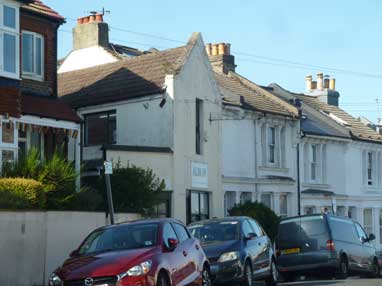
Developed as a stable block and carriage house attached to Princes Villa and built in 1896 by Bennet and Denman. A commercial chimney in render with a cornice to the rear may have architectural and historic significance.
(C4) 36B and C-Princes Road (south side)
The development of 36b and 36c in the mid 1920s as “Hillcrest” and :”Coliemore” in the gardens of Princes Villa separating the stable block from the main house.
38- 44 (evens)-Princes Road (south si
Nos. 38-76, which lie between Crescent Road and Mayo Road, form an almost continuous terrace of paired houses on the south-east side, of two storeys with canted bays and bracketed eaves. No. 38 was built by Marsden in 1880 as were nos. 40-46.
junction with MAYO ROAD
Gothic flint cottages
48 & 50-(even) Princes Road (south side)
[d] The Flint House now Nos 50 & 48 (as pictured)
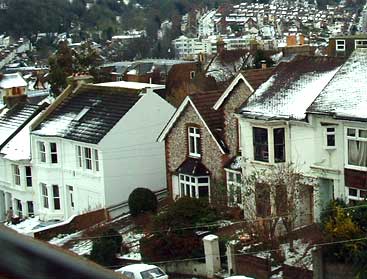
The lower floor of No 48 - the gabled flint house (just west of the cul-de-sac now known as "The Copse") built in 1875, was used over several owners as a laundry. No 48 was renumbered as No 50 in 1895 when a narrow extension was added (also gabled and in flint).
The extension - the taller and narrower of the flint gables higher up the hill - was planned as a purpose-built laundry under Mrs Richardson after several owners had used the wider gabled section as a laundry. The street directories (linked to at the foot of this page) show that 48-50 remains is still being used as a laundry under W.J. Long in 1929 (plenty of space in the Copse for drying) see Pikes Street Directory.
No 50 was later lived in by Mr Fisher, owner of te golf ball factory within the large semi-detached villa at 21-23 Richmond Road.
Mr Fisher, who owned several local properties, let out the extension to small businesses. The extension at No 48 has since been a tie factory and home to Zebra Brakes (brake lining service), though more recently it has been enjoyed as a home both by a relative of Mr Fisher as well as by other residents drawn to the character of the building as well as evidence of a friendly and active community.
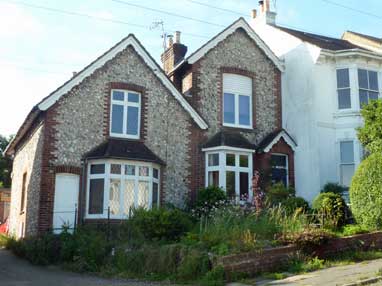
The current 50 Princes Road was built in 1875 and first occupied by Anne & John Cheal. It was first listed as Hill House in the 1878 Post Office Directory and subsequently as Hill Cottage in the Pages Directory where it was first numbered 48 Princes Road. The Pages Directory of 1895 shows it to have been renumbered as No 50 after a purpose built laundry had been added (the narrower of the gabled flint houses) claiming No 48. The land to the rear became a nursery by 1889, and by 1890 the extended house and grounds operated as a laundry and drying.
Gabled flint house or houses with diamond leaded casement windows and used over several owners as a laundry.
Unusual in the context of the Round Hill neighbourhood, mainly of render/stucco and Neo- classical details. The evocation of the vernacular cottage points to the English domestic revival of the mid-to-late 19th Century.
The house now at no. 50 is clearly different. It was built slightly earlier than the rest of the terrace, sitting back slightly from the building line. It is built from flint with red brick quoins to the windows and corners and some original leaded lights. The two storey building has carved barge boards and two gables facing the street.
(C11a) To the rear of 50 Princes Road (south side)
Beside no. 50 an access drive known as “The Copse” leads to three modern houses with garages which cannot be seen from Princes Road.
Long Views
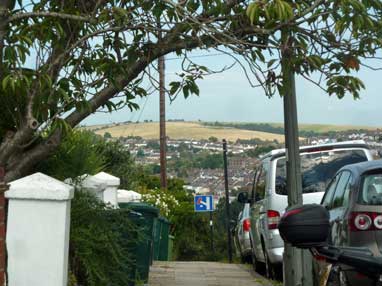
Long views are important to a densely populated conservation area because they contribute a feeling of openness, reminding us of our proximity to the Downs and the sea. Princes Road’s best long view is looking east from the brow of the hill over the Lewes Road valley towards the downland beyond Bevendean and Moulsecoomb.

Looking west from Princes Road over the chimneys of Ditchling Rise towards the mainline from Brighton to London is a reminder of the railway history of the area.
Brighton Station including the train sheds is a Grade II listed building. Its depot was opened in 1848 as a carriage works by the London, Brighton and South Coast Railway.

1 to 76 Princes Road (334 residents in 1891)
Click here for single column of the jobs in alphabetical order.
[a] Occupations in order of house numbers 1 - 76 (odds N side and evens S side, though the last listed job "Railway Signalman" relates to railway cottage on the N side at the east end of Princes Road.
Notice the frequency of railway related jobs as well as laundries.
In 1891, the term "scholar" generally relates to childen aged between 4 and 12 either receiving daily schooling or home tuition on a regular basis.
Professor of Music, Needlewoman, Dressmaker, Scholar, Foreman Telegraph Works, Scholar, Scholar, Scholar, Scholar, Journalist Reporter, Bootmaker, Errand Boy, Scholar,Scholar, Assistant in Estates Office, Milliner, Wool Worker, Art Gallery Assistant, Railway Engine Driver, Dressmaker,Hotel Waiter, Solicitors Clerk, Scholar, Scholar, Gardener, Drapers Assistant, Cashier, Scholar, Scholar, Railway Warehouse Clerk, Scholar, Scholar, Scholar, Scholar, Tinsmith, Chemists Assistant, Boiler Makers Assistant, Passenger Guard LBSC Railway, Scholar, Scholar, Scholar, Scholar,Telegraph Messenger, Railway Porter, Scholar, Scholar, Clerk Railway Booking, Railway Porter, Carpenter House, Railway Guard, Railway Guard, Railway Guard LBSC Railway, Boiler Maker Holder Up, Printers Apprentice, Scholar, Scholar, Scholar, Scholar, Dressmaker, Railway Ticket Collector, Scholar, Signalman, Servant, Railway Ticket Collector, Solicitors Shorthand Clerk, Railway Guard, Railway Clerk, Scholar, Railway Clerk, Railway Guard, Scholar, Scholar, Living On Own Means, Printers Apprentice, Scholar, Scholar, Scholar, Engineers Assistant, Boot Maker, Kitchenmaid Domestic, Messenger, Scholar, Scholar, Scholar, Scholar, Caretaker Board School, General Agent, School Master, Boilermaker Railway Works, Carpenter Railway,Railway Porter, Coachmakers Apprentice, School Teacher, Timber / Firewood Merchant, Scholar, Scholar, Scholar, Foreman Railway Wagon Makers, Railway Carriage Maker, Dressmaker, Scholar, Scholar, Railway Porter, Scholar, Auctioneers Porter, Scholar, Laundress, Painters Apprentice, Scholar, Scholar, Bricklayers Labourer, Railway Guard, Living On Own Means, Engine Boiler Maker, Scholar, Scholar, Dressmaker, House Painter, Laundress, Scholar, Scholar, Scholar, General Servant, Boot Maker, Laundress, Laundress Assistant, Scholar, Engine Fitter, Engine Fitters Apprentice, Laundress, Carpenter House,Tailor, Railway Porter, Scholar, General Servant, Carpenter House, Brush Maker, Scholar, Scholar, Time Keeper Railway Works, General Servant, Scholar, Scholar, Scholar, Scholar, Scholar, Living On Own Means, Bricklayers Labourer, Teacher in Grammar School, Dressmaker, Laundryman, Laundress, Laundress, Carpenter House, Brewers Clerk, Scholar, Scholar, Scholar, House Painter, Laundress, Living On Own Means, Laundry Man, Laundress, Water Meter Inspector, Clerk Estate Agents, Scholar, Laundryman, Laundress, Fireman Railway, Fireman Railway, Laundry Maid, Engine Driver, Scholar, Laundress, Potman, Ironer, Ironer, Scholar, Scholar, Scholar, Labourer Corporation, Scholar, Insurance Agent Life, Rubber Medical, Photographer,Clerk Drapers, Hair Dresser, Clerk Engineers, Foreman Of Dust Carts, Scholar, Scholar, Scholar, Scholar, Printers Clerk, Joiner Building Trade, Joiner Building Trade, Tailoress, Gardener, General Labourer, Laundress, Living On Own Means, Gardener, Scholar, Scholar, Scholar, Scholar, Police Constable, Labourer, Platelayer, Charwoman, Scholar, Living On Own Means, Nurse, Scholar, Scholar, Railway Signalman, Errand Boy, Scholar, Scholar, Scholar, Scholar.

When the houses were built
1875 50 Princes Road.
1878 9-27 Princes Road.
1878 39-53 Princes Road.
1879 2-8 Princes Road.
1879 10-12 Princes Road.
1879 18-24 Princes Road.
1879 58-76 Princes Road.
1880 38 Princes Road.
1880 40-46 Princes Road.
1880 59 Princes Road.
1880 61-75 Princes Road.
1881 14 and 16 Princes Road.
1882 1-7 Princes Road.
1882 26-32 Princes Road.
1884 34 & 36 Princes Road.
1890 52, 54 and 56 Princes Road.
1896 29 & 32 Princes Road.
1896 36c Princes Road.
1902 69 and 71 Princes Road (note: not built till mid 1920s).
Round Hill history texts
Ashdown Road | Belton Road | Crescent Road | D'Aubigny Road | Ditchling Road | Lennox Passage (The Cats Creep) | Mayo Road | Princes Crescent | Princes Road | Richmond Road | Round Hill Crescent | Round Hill Road | Round Hill Street | Wakefield Road